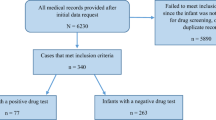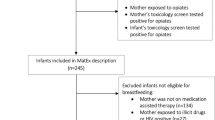Abstract
OBJECTIVE: To evaluate the effect of Early Start, a managed care organization's obstetric clinic-based perinatal substance abuse treatment program, on neonatal outcomes.
STUDY DESIGN: Study subjects were 6774 female Kaiser Permanente members who delivered babies between July 1, 1995 and June 30, 1998 and were screened by completing prenatal substance abuse screening questionnaires and urine toxicology screening tests. Four groups were compared: substance abusers screened, assessed, and treated by Early Start (“SAT,” n=782); substance abusers screened and assessed by Early Start who had no follow-up treatment (“SA,” n=348); substance abusers who were only screened (“S,” n=262); and controls who screened negative (“C,” n=5382).
RESULTS: Infants of SAT women had assisted ventilation rates (1.5%) similar to control infants (1.4%), but lower than the SA (4.0%, p=0.01) and S groups (3.1%, p=0.12). Similar patterns were found for low birth weight and preterm delivery.
CONCLUSION: Improved neonatal outcomes were found among babies whose mothers received substance abuse treatment integrated with prenatal care. The babies of SAT women did as well as control infants on rates of assisted ventilation, low birth weight, and preterm delivery. They had lower rates of these three neonatal outcomes than infants of either SA or S women.
This is a preview of subscription content, access via your institution
Access options
Subscribe to this journal
Receive 12 print issues and online access
$259.00 per year
only $21.58 per issue
Buy this article
- Purchase on Springer Link
- Instant access to full article PDF
Prices may be subject to local taxes which are calculated during checkout
Similar content being viewed by others
References
Shiono PH . Prevalence of drug-exposed infants. Future Child 1996; 6(2): 159–63.
Chomitz VR, Cheung LW, Lieberman E . The role of lifestyle in preventing low birth weight. Future Child 1995; 5(1): 121–38.
Dattel BJ . Substance abuse in pregnancy. Semin Perinatol 1990; 14(2): 179–87.
Ostrea EM Jr, Welch RA . Detection of prenatal drug exposure in the pregnant woman and her newborn infant. Clin Perinatol 1991; 18(3): 629–45.
Kaye K, Elkind L, Goldberg D, Tytun A . Birth outcomes for infants of drug abusing mothers. NY State J Med 1989; 89(5): 256–61.
Bauer CR . Perinatal effects of prenatal drug exposure. Neonatal aspects. Clin Perinatol 1999; 26(1): 87–106.
Paine LL, Garceau LM . Health behaviors during pregnancy: risks and interventions. In: McCormick MC, Siegel JE, editors. Prenatal Care. Effectiveness and Implementation. New York: Cambridge Univ. Press. 1999p33–62.
Office of Disease Prevention and Health Promotion Department of Health and Human Services. Healthy People 2010: Vol. II. Objectives for Improving Health (Part B) 2001
Greenhouse L Program of drug-testing pregnant women draws a review by the Supreme Court. New York: NY Times. 2000
Greenhouse L . Should a fetus' well-being override a mother's rights? New York: NY Times. 2000
Nieves E . California gets set to shift on sentencing drug users New York: NY Times. 2000
Chazotte C, Youchah J, Freda MC . Cocaine using during pregnancy and low birth weight: the impact of prenatal care and drug treatment. Semin Perinatol 1995; 19(4): 293–300.
Keith LG, MacGregor S, Friedell S, Rosner M, Chasnoff IJ, Sciarra JJ . Substance abuse in pregnant women: recent experience at the Perinatal Center for Chemical Dependence of Northwestern Memorial Hospital. Obstet Gynecol 1989; 73(5, Part 1): 715–20.
Lanehart RE, Clark HB, Kratochvil D, Rollings JP, Fidora AF . Case management of pregnant and parenting female crack and polydrug abusers. J Subst Abuse 1994; 6(4): 441–8.
Green M, Silverman I, Suffet F, Taleporos E, Turkel WV . Outcomes of pregnancy for addicts receiving comprehensive care. Am J Drug Alcohol Abuse 1979; 6(4): 413–29.
Armstrong MA, Lieberman L, Carpenter DM, et al. Early start: an obstetric clinic-based, perinatal substance abuse intervention program. Qual Manage Health Care 2001; 9(2): 6–15.
Selby JV . Linking automated databases for research in managed care settings. Ann Intern Med 1997; 127(8, Part 2): 719–24
Escobar GJ . The neonatal “sepsis work-up”: personal reflections on the development of an evidence-based approach toward newborn infections in a managed care organization. Pediatrics 1999; 103(1, Supplement E): 360–73.
Escobar GJ, Li DK, Armstrong MA, et al. Neonatal sepsis workups in babies >=2000 grams at birth: a population-based study. Pediatrics 2000; 106(2): 256–63.
Escobar GJ, Fischer A, Kremers R, Usatin MS, Macedo AM, Gardner MN . Rapid retrieval of neonatal outcomes data: the Kaiser Permanente Neonatal Minimum Data Set. Qual Manage Health Care 1997; 5(4): 19–33.
Escobar GJ, Joffe SJ, Gardner MN, Armstrong MA, Folck BF, Carpenter DM . Rehospitalization in the first two weeks after discharge from the Neonatal Intensive Care Unit. Pediatrics 1999; 104(1): 1–9.
Escobar GJ, Gardner MN, Chellino M, Fireman B, Verdi J, Yanover M . Identification of neonatal deaths in a large managed care organization. Paediatr Perinat Epidemiol 1997; 11(1): 93–104.
Cavalier S, Escobar GJ, Fernbach SA, Quesenberry CP Jr, Chellino M . Postdischarge utilization of medical services by high-risk infants: experience in a large managed care organization. Pediatrics 1996; 97(5): 693–9.
Zupancic JA, Richardson DK . Characterization of the triage process in neonatal intensive care. Pediatrics 1998; 102(6): 1432–6.
Richardson DK, Tarnow-Mordi WO, Escobar GJ . Neonatal risk scoring systems. Can they predict mortality and morbidity?. Clin Perinatol 1998; 25(3): 591–611.
Richardson DK, Zupancic JAF, Escobar GJ, Ogino M, Pursley DM, Mugford M . A critical review of cost-reduction in neonatal intensive care: I. The structure of costs. J Perinatol 2001; 21(2): 107–15.
Bishai R, Koren G . Maternal and obstetric effects of prenatal drug exposure. Clin Perinatol 1999; 26(1): 75–86vii
Colmorgen GH, Johnson C, Zazzarino MA, Durinzi K . Routine urine drug screening at the first prenatal visit. Am J Obstet Gynecol 1992; 166(2): 588–90.
Osterloh JD, Lee BL . Urine drug screening in mothers and newborns. Am J Dis Child 1989; 143(7): 791–3.
McCormick MC . The contribution of low birth weight to infant mortality and childhood morbidity. N Engl J Med 1985; 312(2): 82–90.
Hein H, Lofgren M . The changing pattern of neonatal mortality in a regionalized system of perinatal care: a current update. Pediatrics 1999; 104(5, Part 1): 1064–9
Paneth NS . The problem of low birth weight. Future Child 1995; 5(1): 19–34.
Kramer MS, Demissie K, Yang H, Platt RW, Sauve R, Liston R . The contribution of mild and moderate preterm birth to infant mortality. Fetal and Infant Health Study Group of the Canadian Perinatal Surveillance System. JAMA 2000; 284(7): 843–9.
McCormick MC, Shapiro S, Starfield BH . Rehospitalization in the first year of life for high-risk survivors. Pediatrics 1980; 66(6): 991–9.
Hack M, DeMonterice D, Merkatz IR, Jones P, Fanaroff AA . Rehospitalization of the very-low-birth-weight infant. A continuum of perinatal and environmental morbidity. Am J Dis Child 1981; 135(3): 263–6.
Hack M, Caron B, Rivers A, Fanaroff AA . The very low birth weight infant: the broader spectrum of morbidity during infancy and early childhood. J Dev Behav Pediatr 1983; 4(4): 243–9.
Mutch L, Newdick M, Lodwick A, Chalmers I . Secular changes in rehospitalization of very low birth weight infants. Pediatrics 1986; 78(1): 164–71.
Mutch L Patterns of Hospitalization in the First Two Years of Life: The Influence of Birth Weight and Changing Survival Rates. Report to the Department of Health and Social Security, August 1987. National Perinatal Epidemiology Unit. 1987
Shankaran S, Cohen SN, Linver M, Zonia S . Medical care costs of high-risk infants after neonatal intensive care: a controlled study. Pediatrics 1988; 81(3): 372–8.
Pollack MM, Wilkinson JD, Glass NL . Long-stay pediatric intensive care unit patients: outcome and resource utilization. Pediatrics 1987; 80(6): 855–60.
Jijon CR, Jijon-Letort FX . Perinatal predictors of duration and cost of hospitalization for premature infants. Clin Pediatr (Philadelphia) 1995; 34(2): 79–85.
Bohin S, Draper ES, Field DJ . Impact of extremely immature infants on neonatal services. Arch Dis Child Fetal Neonatal Ed 1996; 74(2): F110–3.
McCormick MC . Prenatal care — necessary but not sufficient. Health Serv Res 2001; 36(2): 399–403.
Acknowledgements
The authors thank Amy Conway, MPH, the former Associate Early Start Coordinator for Kaiser Permanente in Northern California, for technical assistance and input; and the Early Start Specialists for data collection and their dedication to the program.
Author information
Authors and Affiliations
Additional information
This project was supported by a grant from the Direct Community Benefit Investment Fund of the Kaiser Foundation Research Institute, Oakland, CA.
Rights and permissions
About this article
Cite this article
Armstrong, M., Gonzales Osejo, V., Lieberman, L. et al. Perinatal Substance Abuse Intervention in Obstetric Clinics Decreases Adverse Neonatal Outcomes. J Perinatol 23, 3–9 (2003). https://doi.org/10.1038/sj.jp.7210847
Published:
Issue Date:
DOI: https://doi.org/10.1038/sj.jp.7210847
This article is cited by
-
A Comprehensive Care Approach for Pregnant Persons with Substance Use Disorders
International Journal of Mental Health and Addiction (2023)
-
Improved Maternal and Infant Outcomes with Serial, Self-Reported Early Prenatal Substance Use Screening
Maternal and Child Health Journal (2021)
-
Correlates of Pregnant Women’s Participation in a Substance Use Assessment and Counseling Intervention Integrated into Prenatal Care
Maternal and Child Health Journal (2020)
-
Neonatal abstinence syndrome
Nature Reviews Disease Primers (2018)
-
Psychiatric Co-Morbidities in Pregnant Women with Opioid Use Disorders: Prevalence, Impact, and Implications for Treatment
Current Addiction Reports (2017)



